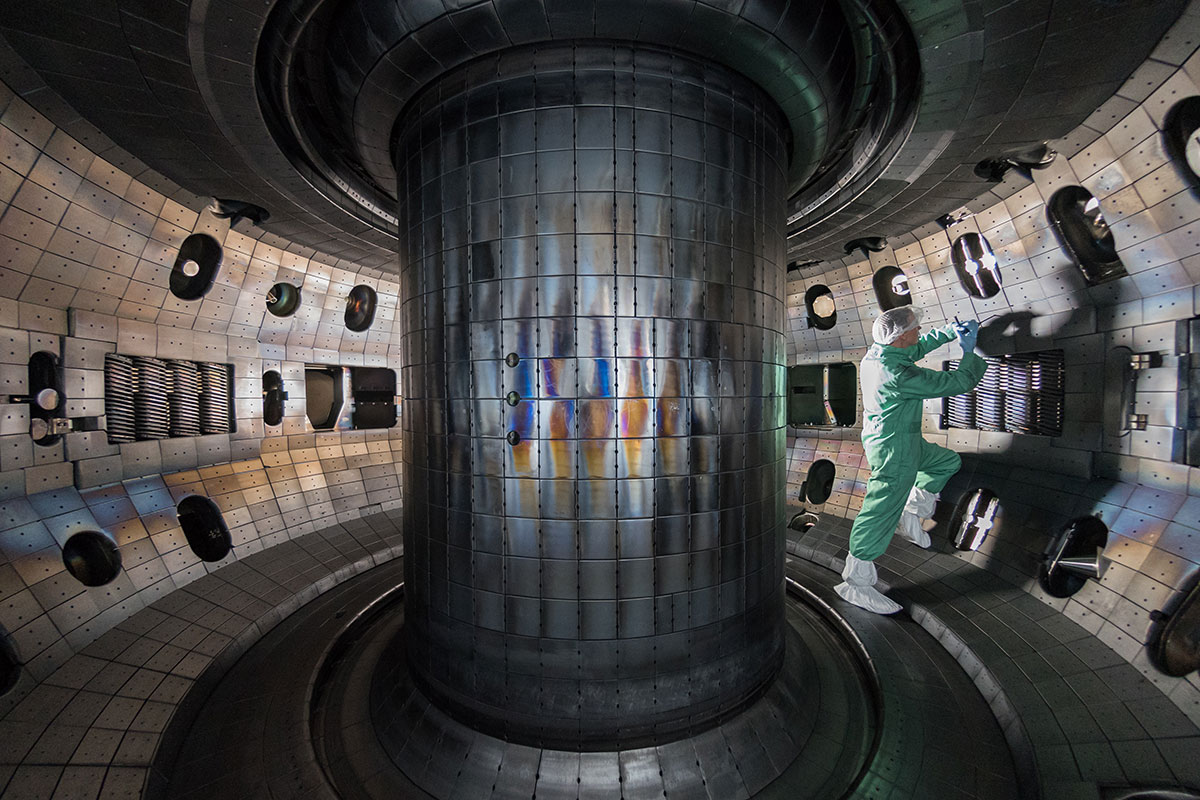DIII-D University Collaborators Receive Funding from Department of Energy

Collaborative Fusion Energy Research Awards help advance science of practical fusion energy
San Diego, July 30, 2019 – The U.S. Department of Energy (DOE) on Monday announced $14 million in awards to ten universities across the country to pursue fusion energy research at the DIII-D National Fusion Facility in San Diego. A major goal of the research is to develop and test innovative methods for understanding and sustaining high-temperature fusion plasmas, a key enabling step towards making fusion a virtually limitless source of practical energy.
The projects range from computer simulations of the complex dynamics of fusion plasmas to deployment of diagnostic devices to techniques for understanding and controlling plasmas relevant to the international ITER experiment under construction in France. All of the projects will allow university researchers to apply work done at their home institutions in a realistic fusion environment at DIII-D, the largest magnetic fusion research facility in the U.S.
“Our university collaborators are a critical part of the work we do at DIII-D, as well as the broader U.S. fusion community,” said Wayne Solomon, deputy director of DIII-D. “By supporting university research, DOE helps to attract the best minds in fusion to advance the state of the art for the entire field and bring closer the realization of sustainable energy from fusion.”
DIII-D, which General Atomics operates as a national user facility for DOE’s Office of Science, hosts researchers from more than 100 institutions across the globe, including 40 universities. The heart of the facility is a tokamak that uses powerful electromagnets to produce a doughnut-shaped magnetic bottle for confining a fusion plasma. In DIII-D, plasma temperatures more than 10 times hotter than the Sun are routinely achieved. At such extremely high temperatures, hydrogen isotopes can fuse together and release energy. (See Fusion Energy 101 explainer below for more detail on how fusion works.)
The ten projects funded Monday by the Office of Fusion Energy Sciences within DOE’s Office of Science strongly support DIII-D’s mission to inform ITER design and operations while preparing the physics basis for future fusion facilities seeking to capitalize on the knowledge generated by ITER on the path to fusion energy.
One of the projects is led by University of California San Diego (UCSD) researcher Jose Boedo, who is working with his students and post-doctoral researchers to understand the physics of how a 100-million-degree plasma can interface with the physical boundaries of the tokamak without damaging the vessel. Boedo said his students benefit from working on a world-class facility like DIII-D, and invariably some of them are inspired to take up the cause of harnessing fusion as a nearly limitless source of energy.
“This is a unique opportunity for them and something that only happens to a very small percentage of physics students,” said Boedo, who has been a DIII-D collaborator for more than 20 years. “They get to have this tremendous experience and work on something that is truly important for the future of humankind. Very few people in the world get to have this type of opportunity.”
In addition to UCSD, the other universities that received awards were the University of Wisconsin, Madison; Princeton University; University of California, Los Angeles; University of California, Irvine; Purdue University; Massachusetts Institute of Technology; Columbia University; Lehigh University; and Auburn University.
About General Atomics: General Atomics pioneers technologies with the potential to change the world. Since the dawn of the atomic age, GA’s innovations have advanced the state of the art across the full spectrum of science and technology – from nuclear energy and defense to medicine and high-performance computing. Behind a talented global team of scientists, engineers, and professionals, GA delivers safe, sustainable, and economical solutions to meet growing global demands.
About the DIII-D National Fusion Facility. DIII-D is the largest magnetic fusion research facility in the U.S. and has been the site of numerous pioneering contributions to the development of fusion energy science. DIII-D continues the drive toward practical fusion energy with critical research conducted in collaboration with more than 600 scientists representing over 100 institutions worldwide. For more information, visit www.ga.com/diii-d.
For more information contact:
Zabrina Johal
858-455-4004
Zabrina.Johal@ga.com
Fusion Energy 101
- Nuclear fusion occurs when light elements such as hydrogen are brought together at extremely high temperatures and pressures, causing the nuclei to fuse into heavier elements such as helium. This process powers stars like our sun and releases vast amounts of energy.
- Fusion differs from nuclear fission, where heavy elements split into lighter elements, releasing energy. Fission is the process used in existing commercial nuclear power plants.
- Fusion power plants will be fueled by a mixture of hydrogen isotopes: deuterium (the nucleus comprises a proton and a neutron) and tritium (the nucleus comprises a proton and two neutrons).
- Deuterium can be extracted from seawater and tritium can be created from small amounts of lithium in the reactor, making fusion a nearly limitless, carbon-free source of energy that leaves no long-lived radioactive waste.
- One way to achieve fusion on earth is in a tokamak (a doughnut-shaped metal vacuum chamber) surrounded by extremely powerful magnets that create strong magnetic fields.
- Creating fusion in a tokamak requires that the fuel be converted into a plasma by heating it to over 100 million degrees.
- Plasma is the “fourth state of matter” in which electrons are stripped from the nuclei of their atoms. This creates an electric charge that allows the plasma to be confined by the magnetic fields within the tokamak without touching the inside walls.
- Plasma is the most common state of matter in the universe. It can be seen all around us in places such as the stars, lightning, and fluorescent light bulbs.
- Tokamaks are inherently safe – any loss of control causes the plasma to touch the inside wall, immediately cooling it and stopping the fusion reaction.